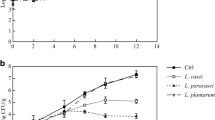Abstract
Paraplantaricin L-ZB1 was produced by Lactobacillus paraplantarum L-ZB1, which was isolated from the traditional China fermented sausage. In this work, paraplantaricin L-ZB1 was used to maintain quality of rainbow trout fillets at 4 °C. Rainbow trout fillets were left untreated (CK) or treated with 200 activity units (AU)/ml paraplantaricin L-ZB1 (P1), 400 AU/ml paraplantaricin L-ZB1 (P2) or 200 AU/ml Nisin (N). The treated samples were stored at 4 °C for up to 10 days, and the quality changes were determined by microbiological (total viable count [TVC], Enterobacteriaceae, Pseudomonas, spore-forming bacteria), sensory, chemical (pH, total volatile basic nitrogen [TVB-N]) and biochemical (biogenic amines, K value) methods. Results show that paraplantaricin L-ZB1 could inhibit the growth of microflora, especially Enterobacteriaceae, Pseudomonas and spore-forming bacteria during sample storage. Meanwhile, the increases of pH, TVB-N, K value and biogenic amine levels were significantly delayed in paraplantaricin L-ZB1-treated samples compared to the control group. Paraplantaricin L-ZB1 of 400 AU/ml extended the rainbow trout fillets’ shelf life to 4–6 days, and the sample showed good sensory characteristics. Therefore, paraplantaricin L-ZB1 could be used as a suitable biological preservative for chilled rainbow trout fillets.





Similar content being viewed by others
References
Mohan, C. O., Ravishankar, C. N., & Srinivasagopal, T. K. (2008). Journal of the Science of Food and Agriculture, 88, 442–448.
Mexis, S. F., Chouliara, E., & Kontominas, M. G. (2009). Food Microbiology, 26, 598–605.
Rahimabadi, E. Z., Rigi, M., Rahnama, M., Safari, R., Arshadi, A., & Barani, M. (2012). Probiotics and Antimicrobial Proteins, 4, 116–121.
Lu, F., Ding, Y., Ye, X., & Liu, D. (2010). LWT Food Science and Technology, 43, 1331–1335.
Oraei, M., Motalebi, A. A., Hoseini, E., & Javan, S. (2011). Iranian Journal of Fisheries Sciences, 10, 75–84.
Cleveland, J., Montville, T. J., Nes, I. F., & Chikindas, M. L. (2001). International Journal of Food Microbiology, 71, 1–20.
Jack, R. W., Tagg, J. R., & Ray, B. (1995). Microbiological Reviews, 59, 171–200.
Delves-Broughton, J., Blackburn, P., Evans, R. J., & Hugenholtz, J. (1996). Antonie Van Leeuwenhoek, 69, 193–202.
Calo-Mata, P., Arlindo, S., Boehme, K., de Miguel, T., Pascoal, A., & Barros-Velazquez, J. (2008). Food and Bioprocess Technology, 1, 43–63.
De Man, J. C., Rogosa, D., & Sharpe, M. E. (1960). Journal of Applied Microbiology, 23, 130–135.
Reenen, V. (1998). Journal of Applied Microbiology, 84, 1131–1137.
Warm, K., Boknass, N., & Nielsen, J. (1998). Journal of Aquatic Food Product Technology, 7, 45–59.
Özoğul, F., & Özoğul, Y. (2000). Turkish Journal of Zoology , 24, 113–120.
Shi, C., Cui, J., Lu, H., Shen, H., & Luo, Y. (2012). Journal of the Science of Food and Agriculture, 92, 3079–3084.
Veciana-Nogués, M. T., Mariné-Font, A., & Vidal-Carou, M. C. (1997). Journal of Agricultural and Food Chemistry, 45, 2036–2041.
Ryder, J. M. (1985). Journal of Agricultural and Food Chemistry, 33, 678–680.
Aubourg, S. P., Piñeiro, C., Gallardo, J. M., & Barros-Velazquez, J. (2005). Food Chemistry, 90, 445–452.
Gram, L., & Huss, H. H. (1996). International Journal of Food Microbiology, 33, 121–137.
Ward, D. R., & Baj, N. J. (1988). Food Technology, 42, 85–89.
Frangos, L., Pyrgotou, N., Giatrakou, V., Ntzimani, A., & Savvaidis, I. N. (2010). Food Microbiology, 27, 115–121.
Gram, L., & Dalgaard, P. (2002). Current Opinion in Biotechnology, 13, 262–266.
Delgado, A., Brito, D., Fevereiro, P., Peres, C., & Marques, J. F. (2001). Le Lait, 81, 203–215.
Yamato, M., Ozaki, K., & Ota, F. (2003). Microbiological Research, 158, 169–172.
Chumchalova, J., Stiles, J., Josephsen, J., & Plockova, M. (2004). Journal of Applied Microbiology, 96, 1082–1089.
Chin, H. S., Shim, J. S., Kim, J. M., Yang, R., & Yoon, S. (2001). Food Science and Biotechnology, 10, 461–467.
Hernandez, D., Cardell, E., & Zarate, V. (2005). Journal of Applied Microbiology, 99, 77–84.
Hampikyan, H., & Ugur, M. (2007). Meat Science, 76, 327–332.
Carneiro, De Melo, A., Cassar, C. A., & Miles, R. J. (1998). Journal of Food Protection, ® 61, 839–843.
Castro, P., Padrón, J. C. P., Cansino, M. J. C., Velázquez, E. S., & Larriva, R. M. D. (2006). Food Control, 17, 245–248.
Chytiri, S., Chouliara, I., Savvaidis, I. N., & Kontominas, M. G. (2004). Food Microbiology, 21, 157–165.
Sallam, K. I., Ahmed, A. M., Elgazzar, M. M., & Eldaly, E. A. (2007). Food Chemistry, 102, 1061–1070.
Saito, T., Arai, K., & Matsuyoshi, M. (1959). Nippon Suisan Gakkaishi, 24, 749–750.
Ocaño-Higuera, V. M., Maeda-Martínez, A. N., Marquez-Ríos, E., Canizales-Rodríguez, D. F., Castillo-Yáñez, F. J., Ruíz-Bustos, E., Graciano-Verdugo, A. Z., & Plascencia-Jatomea, M. (2011). Food Chemistry, 125, 49–54.
Özogul, F., Özden, Ö., Özoğul, Y., & Erkan, N. (2010). Food Chemistry, 122, 789–794.
Huss, H. H. (1995). Quality and quality changes in fresh fish. Rome: FAO fisheries technical paper.
Rodríguez, C. J., Besteiro, I., & Pascual, C. (1999). Journal of the Science of Food and Agriculture, 79, 1473–1480.
Paleologos, E. K., Savvaidis, I. N., & Kontominas, M. G. (2004). Food Microbiology, 21, 549–557.
Fernández Salguero, J., & Mackie, I. M. (1987). International Journal of Food Science and Technology, 22, 385–390.
Bodmer, S., Imark, C., & Kneubühl, M. (1999). Inflammation Research, 48, 296–300.
Kurt, Ş., & Zorba, Ö. (2010). Journal of the Science of Food and Agriculture, 90, 2669–2674.
Acknowledgments
This work was supported by Beijing Innovation Team of China Agriculture Research Center System (SCGWZJ 20131105-2) and China National Science Foundation (31071591).
Author information
Authors and Affiliations
Corresponding author
Rights and permissions
About this article
Cite this article
Gui, M., Zhao, B., Song, J. et al. Paraplantaricin L-ZB1, a Novel Bacteriocin and Its Application as a Biopreservative Agent on Quality and Shelf Life of Rainbow Trout Fillets Stored at 4 °C. Appl Biochem Biotechnol 174, 2295–2306 (2014). https://doi.org/10.1007/s12010-014-1160-3
Received:
Accepted:
Published:
Issue Date:
DOI: https://doi.org/10.1007/s12010-014-1160-3




